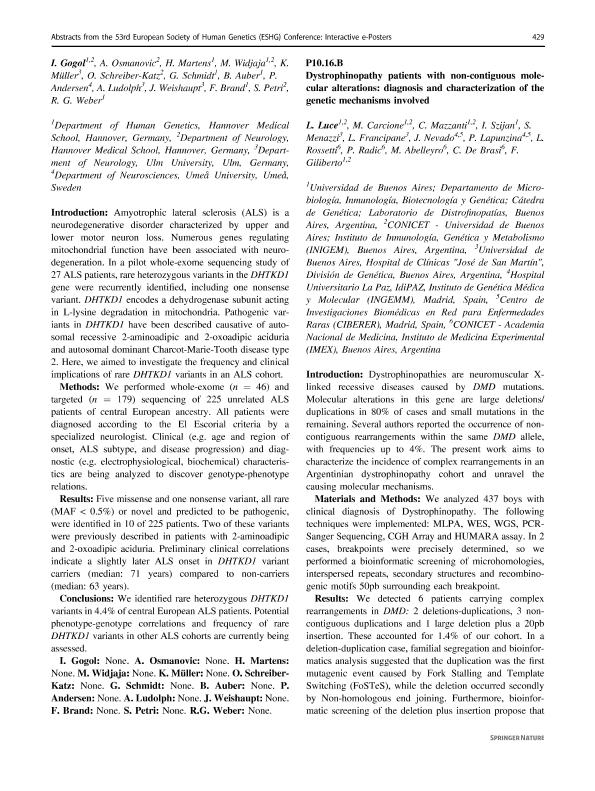Evento
Dystrophinopathy patients with non-contiguous molecular alterations: Diagnosis and characterization of the genetic mechanisms involved
Luce, Leonela Natalia ; Carcione, María Micaela
; Carcione, María Micaela ; Mazzanti, Chiara; Szijan, Irena
; Mazzanti, Chiara; Szijan, Irena ; Menazzi, Sebastian; Francipane, Liliana; Nevado, Julian; Lapunzina, Pablo; Rossetti, Liliana Carmen
; Menazzi, Sebastian; Francipane, Liliana; Nevado, Julian; Lapunzina, Pablo; Rossetti, Liliana Carmen ; Radic, Claudia Pamela
; Radic, Claudia Pamela ; Abelleyro, Miguel Martin
; Abelleyro, Miguel Martin ; de Brasi, Carlos Daniel
; de Brasi, Carlos Daniel ; Giliberto, Florencia
; Giliberto, Florencia
 ; Carcione, María Micaela
; Carcione, María Micaela ; Mazzanti, Chiara; Szijan, Irena
; Mazzanti, Chiara; Szijan, Irena ; Menazzi, Sebastian; Francipane, Liliana; Nevado, Julian; Lapunzina, Pablo; Rossetti, Liliana Carmen
; Menazzi, Sebastian; Francipane, Liliana; Nevado, Julian; Lapunzina, Pablo; Rossetti, Liliana Carmen ; Radic, Claudia Pamela
; Radic, Claudia Pamela ; Abelleyro, Miguel Martin
; Abelleyro, Miguel Martin ; de Brasi, Carlos Daniel
; de Brasi, Carlos Daniel ; Giliberto, Florencia
; Giliberto, Florencia
Tipo del evento:
Conferencia
Nombre del evento:
53rd European Society of Human Genetics Conference
Fecha del evento:
06/06/2020
Institución Organizadora:
Wiener Medizinische Akademie;
European Society of Human Genetics;
Título de la revista:
European Journal Of Human Genetics
Editorial:
Nature Publishing Group
ISSN:
1018-4813
e-ISSN:
1476-5438
Idioma:
Inglés
Clasificación temática:
Resumen
Introduction: Dystrophinopathies are neuromuscular X-linked recessive diseases caused by DMD mutations. Molecular alterations in this gene are large deletions/duplications in 80% of cases and small mutations in the remaining. Several authors reported the occurrence of non-contiguous rearrangements within the same DMD allele, with frequencies up to 4%. The present work aims to characterize the incidence of complex rearrangements in an Argentinian dystrophinopathy cohort and unravel the causing molecular mechanisms.Materials and Methods: We analyzed 437 boys with clinical diagnosis of Dystrophinopathy. The following techniques were implemented: MLPA, WES, WGS, PCR-Sanger Sequencing, CGH Array and HUMARA assay. In 2 cases, breakpoints were precisely determined, so we performed a bioinformatic screening of microhomologies, interspersed repeats, secondary structures and recombinogenic motifs 50pb surrounding each breakpoint. Results: We detected 6 patients carrying complex rearrangements in DMD: 2 deletions-duplications, 3 non-contiguous duplications and 1 large deletion plus a 20pb insertion. These accounted for 1.4% of our cohort. In a deletion-duplication case, familial segregation and bioinformatics analysis suggested that the duplication was the first mutagenic event caused by Fork Stalling and Template Switching (FoSTeS), while the deletion occurred secondly by Non-homologous end joining. Furthermore, bioinformatic screening of the deletion plus insertion propose that the deletion was due to Microhomology-mediated end joining, while the insertion arose by FoSTeS. Conclusions: Our findings widen the understanding of the molecular events that may take place in DMD and characterize the occurrence of complex rearrangements in our dystrophinopathy cohort.This study was supported by PTC Therapeutics and University of Buenos Aires.
Palabras clave:
DMD
,
COMPLEX REARRANGEMENTS
,
FOSTES
,
NHEJ
Archivos asociados
Licencia
Identificadores
Colecciones
Eventos(IMEX)
Eventos de INST.DE MEDICINA EXPERIMENTAL
Eventos de INST.DE MEDICINA EXPERIMENTAL
Eventos(INIGEM)
Eventos de INSTITUTO DE INMUNOLOGIA, GENETICA Y METABOLISMO
Eventos de INSTITUTO DE INMUNOLOGIA, GENETICA Y METABOLISMO
Citación
Dystrophinopathy patients with non-contiguous molecular alterations: Diagnosis and characterization of the genetic mechanisms involved; 53rd European Society of Human Genetics Conference; Vienna; Alemania; 2020; 429-430
Compartir
Altmétricas



